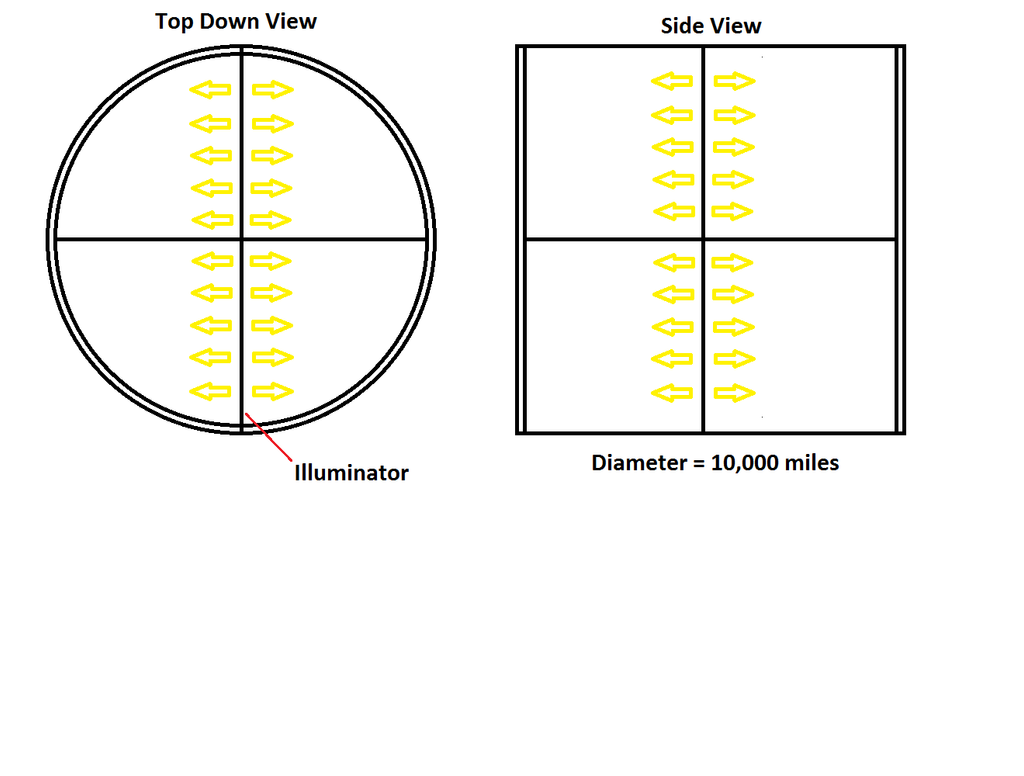New Mars Forums
You are not logged in.
- Topics: Active | Unanswered
Announcement
Pages: 1
#1 2016-05-09 23:58:45
- Tom Kalbfus
- Banned
- Registered: 2006-08-16
- Posts: 4,401
Venus Topopolis
Suppose we did something with Venus other than terraform it? After all, terraforming Venus will yield a world that is slightly smaller than Earth, which can support a human population about equal to Earth's. But what is we took the planet apart and made something else out of it? You ever hear of a Topopolis?
https://en.wikipedia.org/wiki/Topopolis
What if we combined that idea with my idea of terraforming "NoPlanet" basically a giant cylinder that is 10,000 miles in diameter? Venus has a nearly circular orbit that is 67,232,363 miles in radius, and thus has a circumference of 422,433,395 miles. If we assume the cylinder is 10,000 miles in radius, the sun facing outer surface of the Cylinder will have a radius that is 5,000 miles closer or 67,227,363 miles, with a circumference of 422,401,979 miles. The outer surface facing away from the Sun would be 5,000 miles further away than the average radius or 67,237,363 miles in radius, with a circumference of 422,464,811 miles. The difference between outer and inner circumferences is 62,832 miles.
The topopolis has the same internal arrangement as NoPlanet, except in this case the cylinder is 422,433,395 miles long, it rotates once every 134 minutes to produce 1 Earth gravity of centrifugal force, there is an inner sky cylinder that is 10 miles inside/above the outer tube, it produces light, simulating day night, stars and moon making it appear that the habitable surface is on the surface of a planet. The surface of the cylinder has to stretch and contract over the period of its rotation of 134 minutes, this turns out to be 0.015% or the surface has to stretch out to 1.00015 times what its circumference would be when it is rotated inward facing the Sun. Do we have material that can stretch by that amount? You bet!
So now we come to the question, does Venus have enough material to make such a thing?
Venus has an internal volume of 2.227E+11 mi³. Now the formula for the volume of a cylinder is volume = π × diameter × length.
Lets assume the cylinder has a shell that is 1 mile thick, it is 10,000 miles in radius and 422,433,395 miles long, which is the circumference of its orbit around the Sun. What is this volume? Plugging in the numbers we get
Volume = 3.1415926535897932384626433832795 × 10,000 × 422,433,395 = 13,271,136,503,630 mi³
This is of a solid cylinder, now we have to subtract the volume of the empty cavity, which as a diameter of 9,998 miles
Volume = 3.1415926535897932384626433832795 × 9,998 × 422,433,395 = 13,268,482,276,329 mi³
The net volume is 2,654,227,301 mi³ or 2.654E+9 mi³. The sky cylinder is going to be much thinner than the ground cylinder, since all it has to do is hold in atmosphere and be a source of illumination, So most of the volume goes into the floor, and the remaining volume goes to make the ring braces which holds this spinning structure together, the spinning structure is 0.0119 of the total volume of Venus, and this stretches completely around the Sun. We might construct something similar out of the material of the asteroid belt, Though Venus has the advantage of being closer to the Sun, with abundant solar energy and a shorter circumference that goes with it.
Offline
Like button can go here
#2 2024-12-20 12:09:15
- tahanson43206
- Moderator
- Registered: 2018-04-27
- Posts: 23,517
Re: Venus Topopolis
This topic showed up as having no replies...
It's clearly on the fantastic side, and there are NewMars members who tend to like working in that realm.
This post is reserved for an index to posts that might be contributed by NewMars members over time.
I admit the chances of such posts are on the low side. This topic was created in 2016.
(th)
Offline
Like button can go here
Pages: 1